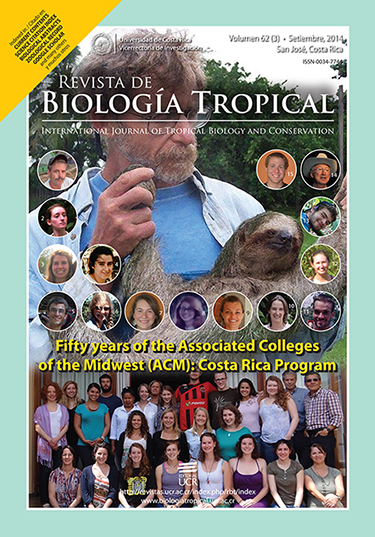Resumen
Las altas tasas de mortalidad se han observado en teleósteos durante las etapas iniciales del desarrollo, así como una gran variación en las tácticas reproductivas, que están relacionados con adaptaciones a las condiciones ambientales y nichos ecológicos con cada especie que presenta una respuesta específica. El objetivo de este estudio fue describir las tácticas reproductivas relacionadas con la supervivencia de la descendencia de Cichlasoma orientale, incluyendo aspectos tales como el tamaño corporal, el cuidado parental, la fecundidad, el tamaño de los ovocitos y los patrones de desove. Las muestras se recolectaron mensualmente desde agosto 2011 hasta julio 2013, en ambientes lénticos y lóticos en la cuenca del río Curu, región semiárida del noreste de Brasil. El comportamiento individual (n=113) se observó bajo el agua durante más de 50 horas por un muestreo ad libitum y muestreo de grupos focales. Para los individuos recolectados (n=185 machos, hembras n=95) se evaluó: la longitud, la fecundidad por camada, el tamaño estándar de los ovocitos y el patrón de desove. En las hembras con ovarios maduros, se observó la cantidad de grupos de ovocitos en diferentes etapas de desarrollo y estas células fueron contadas y medidas y la fecundidad se estimadó por el método gravimétrico. Las especies muestran un comportamiento de cuidado biparental y, en promedio, los machos son más grandes que las hembras. Con base en 46 ovarios, la fecundidad promedio de lotes fue de 2 052±849 (254-3 389). Longitud estándar y fecundidad parcial se correlacionaron positivamente, pero no se encontró correlación entre el tamaño de los ovocitos y la longitud estándar. Los oocitos más desarrollados miden 1.8mm. La distribución observada de las clases de tamaño de los ovocitos indica desarrollo de los ovocitos sincrónico en tres grupos: previtelogénicos, vitelogénicos y maduros, lo que demuestra que C. orientale es una especie con desova múltiple. Se observaron diferencias en la cantidad de ovocitos entre los tres grupos, con el grupo más desarrollada que muestra el menor número de ovocitos. La combinación de la baja fecundidad y gran tamaño del huevo es una característica de los reproductores demersales, debido a una mayor estabilidad del medio ambiente. Múltiples desoves aumenta las posibilidades de supervivencia, principalmente debido al aumento de la fecundidad por temporada reproductiva y reducción de la competencia entre la descendencia. Llegamos a la conclusión de que C. orientale hace una fuerte inversión en la supervivencia de las larvas en detrimento del número de descendientes. La supervivencia se ve favorecida por el gran tamaño de los ovocitos, gran reserva de yema de huevo, cuidado biparental y patrón de desove múltiple.
##plugins.facebook.comentarios##

Esta obra está bajo una licencia internacional Creative Commons Atribución 4.0.
Derechos de autor 2014 Revista de Biología Tropical






